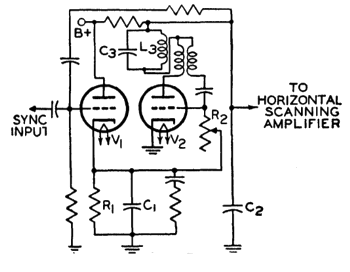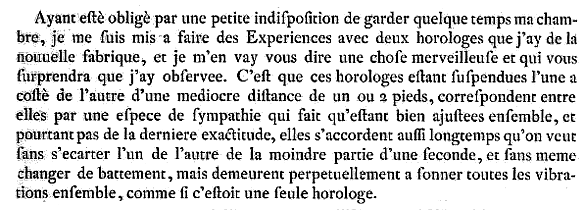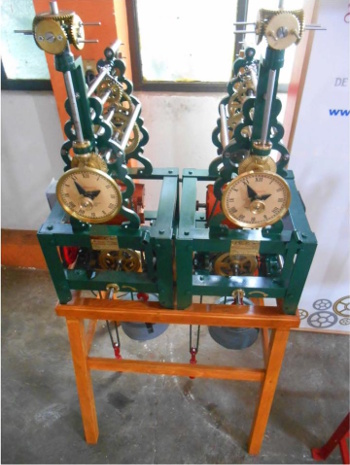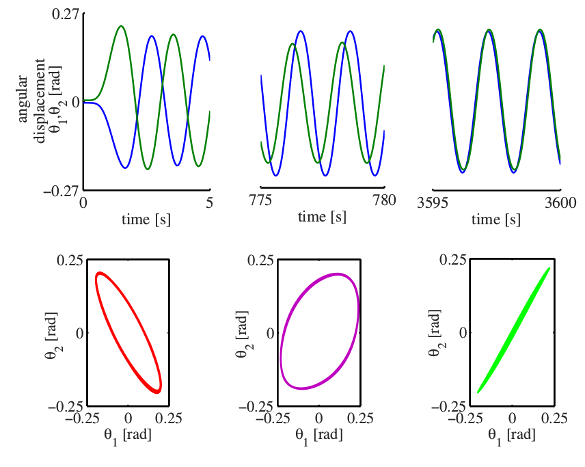Christiaan Huygens' Coupled Pendulums
May 26, 2016
Injection locking is a useful
electronic technique in which one
oscillator is
synchronized to another when they are coupled and their free-running frequencies are close to each other. This is the method that allows
oscilloscopes to display static signal
waveforms by
locking their internal horizontal oscillator to the
signal frequency.
In the age of
analog television, injection locking was the method used to lock the
vido frame to the
screen, and when your set's aged
vacuum tubes weren't quite up to this task, the picture would roll
vertically (see figure).

A vacuum tube horizontal oscillator circuit, fig. 101 from page 73 of the RCA Receiving Tube Manual RC-25, 1966.
This is a sawtooth blocking oscillator in which the synchronizing signal is coupled through the cathodes.
(Scan of author's copy)[1]
Digital television has replaced analog television, and
transistors have superseded vacuum tubes, but such synchronization of electronic oscillators is still used for a number of purposes. Quite importantly, it's possible to lock an oscillator with a frequency that's an
integer fraction of another to produce
frequency division.
A synchronization method called
injection seeding is used to produce greater frequency stability in
high power lasers. Injecting the output of a stable
laser diode into the
resonant path of a high power laser through a
partially transparent mirror "seeds" the
optical resonance to force the laser to operate at the injected frequency.[2]
Injection locking was known long before the invention of the vacuum tube oscillator.
Christiaan Huygens, who invented the
pendulum clock, discovered by accident that two pendulum clocks, hung from a common beam, became synchronized to each other. pendulums (or, pendula, if you prefer) are mechanical oscillators.
Huygens noticed the effect while lying in bed because of an
illness. Interestingly, the pendulums of these clocks swung in exactly opposite directions after their synchronization. Huygens called this effect "odd sympathy," since the pendulums synchronized 180°
out of phase. His discovery was presented to a meeting of the Royal Society on February 27, 1665 (see figure).
 Portion of the February 27, 1665, letter of Christiaan Huygens to R. Moray describing the odd sympathy of two proximate pendulums. The letter was read before the Royal Society. (Source: Page 247 of Ref. 3).
Huygens' first hypothesis was that air currents from each pendulum were influencing the swing of the other. Doing some experiments
Portion of the February 27, 1665, letter of Christiaan Huygens to R. Moray describing the odd sympathy of two proximate pendulums. The letter was read before the Royal Society. (Source: Page 247 of Ref. 3).
Huygens' first hypothesis was that air currents from each pendulum were influencing the swing of the other. Doing some experiments, he found that this wasn't the case, and he decided that the pendulums caused small
mechanical movements of the base that caused the synchronization. He also had the idea that two clocks were better than one; that is, you would get better
timekeeping with a pair of such synchronized clocks.[4]
Modern studies have shown that the frequency precision of a
lattice of N coupled oscillators resists the influence of external noise by a factor of N, at least for smaller N.[5] I presented a computer simulation of the synchronization of three coupled oscillators in an
earlier article (Coupled Oscillators, November 15, 2011). You can view
videos of synchronized pendulums on the
Internet.[6-7]
Huygens' coupled pendulums have continued to interest
scientists after many
centuries. A 2002 study by
researchers at the
Georgia Tech showed that synchronization does not happen in all coupling conditions. In particular, they found that not all twin pendulums perform as Huygens found. If the mounting is too rigid, or the coupling is too small, there will be no synchronization. Mathematical analysis by the Georgia team indicated that pivot
friction is an important aspect of the phenomenon.[8-9]
Just recently, another study of Huygens' coupled pendulums has been published by scientists and
engineers from the
Center for Scientific Research and Higher Education at Ensenada (CICESE, Ensenada, B.C., Mexico), the Department of Production Engineering (
Zacatlan, Puebla, Mexico), and the
Eindhoven University of Technology (Eindhoven, The Netherlands).)[10-11] Their experimental clocks are shown below.

Experimental clocks for the Huygens' experiment.
The pendulum of each is a 5 kilogram metallic mass attached to a 0.99 meter wooden rod.
The experimental setup is slightly different from that of Huygens in that they are supported on an elastic wooden structure, and not hanging from the structure.
(Figs. 2 of ref. 10, also found here, licensed under a Creative Commons Attribution 4.0 International License.)
In this modern version of Huygens' experiment using a different mounting, the coupled clock pendulums oscillate
in-phase, and not in Huygens' "odd sympathy."[10] The researchers created the most detailed mathematical model of this phenomenon to date, and they verified their model through experiment. They were able to disprove a
theory that the synchronization arose from
acoustic pulses, and they showed what conditions allow in-phase and out-of-phase synchronization.[11]

Experimental results for a clock experiment using two representations. The pendulums are originally 180-degrees out of phase, and they then proceed to synchronize over the course if an hour. (Fig. 3a-3c and fig. 4a-4c of ref. 10, licensed under a Creative Commons Attribution 4.0 International License.)
References:
- RCA Receiving Tube Manual RC-25, Radio Corporation Of America, Electronic Components and Devices Harrison, N. J., 1966. Also available as a PDF file on archive.org.
- Rüdiger Paschotta, "Injection Locking," Encyclopedia of Laser Physics and Technology, RP Photonics Consulting GmbH.
- M. Nijhoff, Ed., "Ouevres Completes de Christian Huygens," (Societe Hollandaise des Sciences, The Hague, The Netherlands, 1893), vol. 5, p. 247 (in French).
- Erica Klarreich, "Huygens' Clocks Revisited," American Scientist, vol. 90, no. 4 (July-August 2002).
- M. C. Cross, "Improving the Frequency Precision of Oscillators by Synchronization," arXiv Preprint Server, September 21, 2011.
- Synchronisation of 5 coupled metronomes done in Lancaster University, Physics Department, YouTube Video by abahraminasab, December 18, 2007.
- Two pendulums attached to the same horizontal string transfer their motion back and forth, YouTube Video by Fred Wittel, September 7, 2007.
- Matthew Bennett, Michael F. Schatz, Heidi Rockwood and Kurt Wiesenfeld, "Huygens's clocks," Proc. R. Soc. Lond. A, vol. 458, (March 8, 2002), pp. 563-579.
- Erica Klarreich, "Discovery of Coupled Oscillation Put 17th-Century Scientist Ahead of his Time," SIAM News, vol. 35, no. 8, October, 2002.
- Jonatan Peña Ramirez, Luis Alberto Olvera, Henk Nijmeijer, and Joaquin Alvarez, "The sympathy of two pendulum clocks: beyond Huygens' observations," Scientific Reports, vol. 6, Article no. 23580 (March 29, 2016), doi:10.1038/srep23580. This is an open access paper with a PDF file available here.
- Eindhoven and Mexican researchers prove Huygens was right, Eindhoven University Press Release, March 29, 2016.
Permanent Link to this article
Linked Keywords: Injection locking; electronic; oscillator; synchronization; synchronize; frequency; oscilloscope; waveform; locking; horizontal; signal; analog television; vido frame; cathode ray tube; screen; vacuum tubes; vertical; electronic circuit; RCA; sawtooth wave; blocking oscillator; vacuum tube cathode; transistor; integer; fraction; frequency division; injection seeder; injection seeding; power; laser; laser diode; resonance; resonant path; partially transparent mirror; optics; optical; resonance; Christiaan Huygens; invention; invented; pendulum clock; pendulum; harmonic oscillator; mechanical oscillator; bed; illness; out of phase; Royal Society of London; hypothesis; air current; experiment; classical mechanics; mechanical; timekeeping; lattice; noise; computer simulation; video clip; Internet; scientist; century; research; researcher; Georgia Institute of Technology; Georgia Tech; stiffness; rigid; math; mathematical; analysis; friction; phenomenon; engineer; Center for Scientific Research and Higher Education at Ensenada (CICESE, Ensenada, B.C., Mexico); Zacatlan, Puebla, Mexico; Eindhoven University of Technology (Eindhoven, The Netherlands); kilogram; metal; metallic; mass; meter; wood; elasticity; elastic; Creative Commons Attribution 4.0 International License; in-phase; theory; acoustic; pulse.